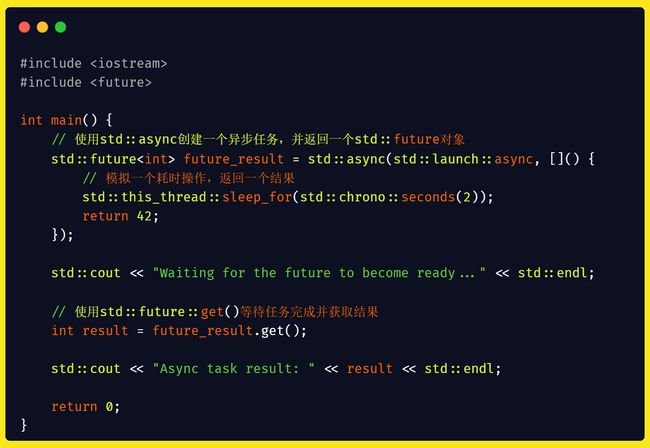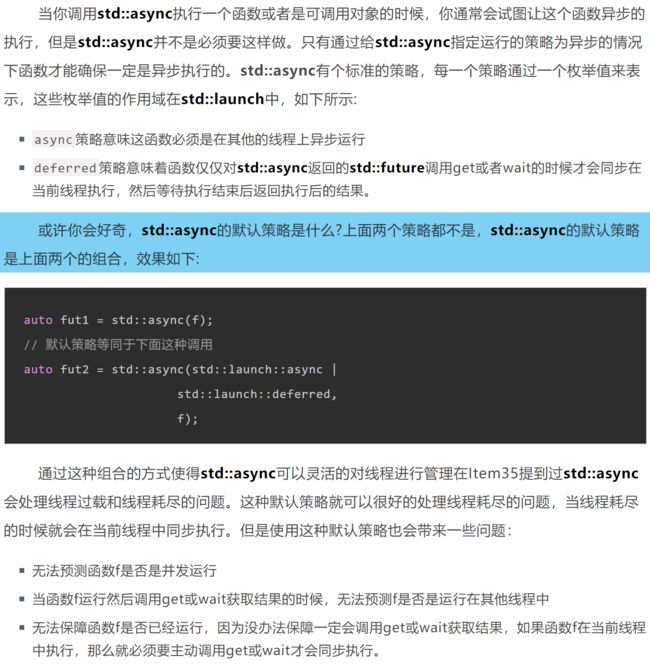C++笔记之std::async的用法
C++笔记之std::async的用法
code review!
文章目录
- C++笔记之std::async的用法
-
- 1.概念
- 2.C++ 异步任务的使用示例 - 使用 std::async 和 std::future
- 3. std::launch::async 和 std::launch::deferred
- 4.如果需要真正的异步,请指定std::launch::async
1.概念
std::async 是 C++ 标准库中的一个函数,用于创建异步任务,允许在另一个线程中执行函数,并返回一个 std::future 对象,以便获取函数的结果。std::async 的一般用法如下:

#include 上述示例中,std::async 接受一个函数(foo)和它的参数,并在后台创建一个新线程来执行该函数。函数执行完毕后,可以使用 std::future 对象的 get() 方法来获取函数的返回值。
以下是 std::async 的一些重要注意事项和用法:
-
返回值类型:
std::async返回一个std::future对象,可以用于获取异步任务的返回值。 -
默认策略:
std::async可以接受一个可选的策略参数,例如std::launch::async和std::launch::deferred,用于指定任务是立即在新线程中执行还是延迟执行。如果不提供策略,默认行为由实现决定。 -
异常处理:如果异步任务抛出异常,
std::future对象的get()方法会重新抛出该异常。因此,需要适当地处理异常,或者使用std::future的wait()和wait_for()方法来检查任务是否出现异常。 -
返回值的共享和移动语义:根据策略,
std::async可能共享或移动参数,因此要小心在异步任务中使用共享数据。 -
后台线程管理:
std::async会自动创建和管理后台线程,但不提供对线程的直接控制。如果需要更多的线程控制功能,可以考虑使用std::thread。 -
取消任务:C++标准库在
std::async中不提供直接的取消任务的机制,因此需要通过其他方式来实现任务的取消。
2.C++ 异步任务的使用示例 - 使用 std::async 和 std::future
运行(GIF动图)
代码
#include 3. std::launch::async 和 std::launch::deferred
std::launch::async 和 std::launch::deferred 是用于控制 std::async 函数的执行策略的标志,它们决定了异步任务的行为。这两个标志可以作为 std::launch 枚举类型的成员来使用。以下是它们的详细解释:
-
std::launch::async:- 当使用
std::launch::async标志调用std::async时,函数将在新的线程中立即执行,即使没有调用std::future对象的get()方法也会执行。 - 这意味着任务会异步执行,不会阻塞当前线程,而是在后台创建一个新线程来执行任务。
- 如果你希望任务尽快执行,并且可以与其他操作并发执行,可以选择此策略。
- 当使用
-
std::launch::deferred:- 当使用
std::launch::deferred标志调用std::async时,函数不会立即执行,而是等待调用std::future对象的get()方法时再执行。 - 这意味着任务会延迟执行,直到你真正需要结果为止。如果未调用
get(),任务可能根本不会执行。 - 这种策略适用于需要懒惰地计算结果的情况,以节省计算资源。
- 当使用
默认情况下,如果不指定策略,std::async 的行为由 C++ 标准库实现决定,可以是 std::launch::async 也可以是 std::launch::deferred,取决于具体实现。因此,为了明确指定策略,你可以使用以下方式:
std::future<int> result = std::async(std::launch::async, foo, 3, 4); // 强制使用 std::launch::async
std::future<int> result = std::async(std::launch::deferred, foo, 3, 4); // 强制使用 std::launch::deferred
需要注意的是,使用 std::launch::async 策略可能会导致并发执行的线程数增加,而使用 std::launch::deferred 策略可能会导致任务延迟执行,因此需要根据具体情况选择适当的策略。
下面是一个完整的比较 std::launch::async 和 std::launch::deferred 策略的示例程序:
#include 在这个示例中,我们首先使用 std::launch::async 和 std::launch::deferred 策略调用了 foo 函数。foo 函数会输出当前线程的标识符。然后,主线程休眠了2秒钟以模拟其他工作。
接着,我们分别调用 async_result.get() 和 deferred_result.get() 来获取两种策略下的结果。你会注意到,std::launch::async 的任务会立即执行(可能已经执行完毕),而 std::launch::deferred 的任务直到调用 get() 时才会执行。
这个示例演示了 std::launch::async 和 std::launch::deferred 的不同行为,以及如何使用它们来控制异步任务的执行方式。


